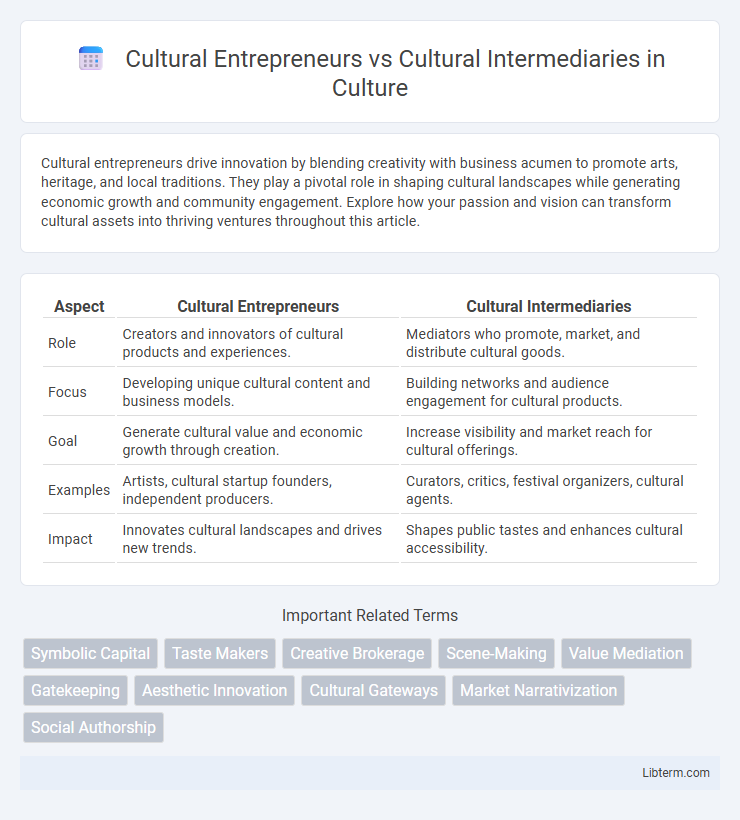Cultural entrepreneurs drive innovation by blending creativity with business acumen to promote arts, heritage, and local traditions. They play a pivotal role in shaping cultural landscapes while generating economic growth and community engagement. Explore how your passion and vision can transform cultural assets into thriving ventures throughout this article.
Table of Comparison
| Aspect | Cultural Entrepreneurs | Cultural Intermediaries |
|---|---|---|
| Role | Creators and innovators of cultural products and experiences. | Mediators who promote, market, and distribute cultural goods. |
| Focus | Developing unique cultural content and business models. | Building networks and audience engagement for cultural products. |
| Goal | Generate cultural value and economic growth through creation. | Increase visibility and market reach for cultural offerings. |
| Examples | Artists, cultural startup founders, independent producers. | Curators, critics, festival organizers, cultural agents. |
| Impact | Innovates cultural landscapes and drives new trends. | Shapes public tastes and enhances cultural accessibility. |
Defining Cultural Entrepreneurs
Cultural entrepreneurs are individuals who create, develop, and promote cultural products or experiences by leveraging innovation and creativity within the cultural sector. They actively shape cultural content, influence consumption patterns, and drive cultural value creation by combining artistic vision with business acumen. Unlike cultural intermediaries, who primarily mediate and facilitate the distribution or reception of cultural goods, cultural entrepreneurs initiate and invest in original cultural ventures.
Understanding Cultural Intermediaries
Cultural intermediaries act as essential connectors within the cultural economy, shaping trends by mediating between creators and consumers. Their roles encompass curating, promoting, and interpreting cultural products, thereby influencing public reception and market success. Understanding cultural intermediaries reveals how they strategically navigate social networks and discursive practices to construct cultural value and facilitate cultural consumption.
Key Differences Between the Two Roles
Cultural entrepreneurs create, produce, and promote original cultural products, driving innovation within the cultural sector by identifying new market opportunities and shaping artistic trends. Cultural intermediaries act as facilitators and connectors, bridging the gap between creators and consumers by curating, marketing, and distributing cultural goods to enhance accessibility and audience engagement. The key difference lies in entrepreneurs generating cultural value through creation and risk-taking, whereas intermediaries focus on valorization and mediation within existing cultural ecosystems.
Core Functions in the Cultural Economy
Cultural entrepreneurs drive innovation by creating and managing cultural products, fostering new forms of artistic expression, and expanding market opportunities within the cultural economy. Cultural intermediaries primarily facilitate connections between creators and consumers by shaping tastes, promoting cultural goods, and influencing consumption patterns through marketing and curatorial activities. Both roles are essential for sustaining cultural value chains, with entrepreneurs focusing on production and intermediaries on distribution and audience engagement.
Impact on Cultural Production and Distribution
Cultural entrepreneurs drive innovation by creating new cultural products and markets, leveraging unique ideas to influence cultural production significantly. Cultural intermediaries shape distribution networks and consumer preferences, acting as gatekeepers who connect cultural products with audiences and enhance their visibility. The impact of cultural entrepreneurs is in generating fresh content, while cultural intermediaries ensure effective dissemination and market penetration.
Social Capital: Networks and Influence
Cultural entrepreneurs leverage social capital through expansive networks and strategic influence to create and promote innovative cultural products or experiences, often driving trends and market opportunities. Cultural intermediaries function by mediating between producers and consumers, utilizing their established networks to shape preferences and legitimize cultural goods within specific communities. Both roles underscore the importance of social capital, though entrepreneurs build it proactively to generate cultural value, whereas intermediaries harness existing networks to facilitate cultural exchange and market penetration.
Role in Shaping Cultural Trends
Cultural entrepreneurs actively create and promote innovative cultural products and experiences, directly influencing emerging trends by introducing novel ideas to the market. Cultural intermediaries, such as critics, curators, and marketers, shape cultural consumption by interpreting, mediating, and legitimizing these trends for broader audiences. Their combined roles drive the evolution and dissemination of cultural practices, with entrepreneurs generating new content and intermediaries guiding its reception and popularity.
Challenges and Opportunities
Cultural entrepreneurs face challenges in securing funding, navigating market uncertainties, and balancing artistic integrity with commercial viability, while opportunities arise from digital platforms that expand audience reach and foster innovative collaborations. Cultural intermediaries encounter difficulties in maintaining credibility and relevance amid rapidly changing consumer preferences but benefit from their strategic position to influence taste and bridge creators with markets. Both roles leverage cultural capital to shape cultural production, yet entrepreneurs actively create new cultural products, whereas intermediaries curate and mediate value between creators and consumers.
Case Studies and Real-World Examples
Cultural entrepreneurs actively create and promote new cultural products, driving innovation in industries such as fashion, music, and art, exemplified by figures like Pharrell Williams, who integrates diverse cultural influences into mainstream media. Cultural intermediaries, including curators, critics, and festival organizers, mediate between creators and consumers by shaping taste and access, as seen in organizations like the Sundance Film Festival that elevate independent filmmakers. Case studies of cultural hubs like Berlin's art scene illustrate how entrepreneurs generate original content while intermediaries structure networks and market pathways for broader audience engagement.
Future Outlook in the Creative Industries
Cultural entrepreneurs are poised to drive innovation and foster new markets in the creative industries by leveraging emerging technologies and global networks. Cultural intermediaries will increasingly focus on bridging the gap between creators and audiences, utilizing data analytics and digital platforms to curate and promote cultural content effectively. The future outlook emphasizes a symbiotic relationship where entrepreneurs shape creative production, while intermediaries amplify cultural value and accessibility.
Cultural Entrepreneurs Infographic

 libterm.com
libterm.com